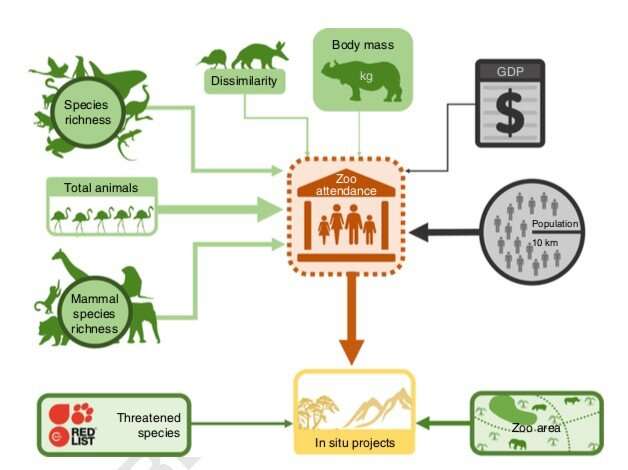Size matters! What drives zoo attendance and how does footfall impact conservation?

Scientists from Trinity College Dublin, Species360 and NUI Galway have quantified what drives attendance to zoos by assessing how variations in animal collections affect footfall. Crucially, they link their findings to the contributions made to conservation efforts in situ (in the wild), and find that zoos are making significant, positive impacts on our attempts to conserve biodiversity.
Among the headline findings are that zoos with lots of animals, lots of different species (particularly mammals), and with large animals such as elephants, tigers and pandas attract higher numbers of visitors. It is difficult for zoos to fulfil all of these requirements simultaneously however as large animals take up a lot of space and resources meaning relatively few can be accommodated.
The research found that instead of a "one size fits all" approach to a zoo collection there are several different strategies that can be used to encourage attendance, including the inclusion of unusual animals. Ultimately higher numbers of visitors led to zoos contributing more conservation activity in the wild.
This research used a global data-set for 458 zoos in 58 countries, including species holdings data from the Zoological Information Management System (ZIMS) managed by Species360. More than 1,200 wildlife institutions curate and share animal data as members of Species360, contributing real-time demographic, medical, genetic, and population insights for more than 22,000 species and 10,000,000 individual animals, both living and historic.
The research has been published today in leading international journal, Nature Communications.
Andrew Mooney, Ph.D. Candidate in Trinity's School of Natural Sciences, is first author on the paper. He said:
"Zoos and aquariums not only breed and maintain populations of thousands of wildlife species but they also act as centres for public education, wildlife rehabilitation, scientific research and public entertainment. Zoos and aquariums attract more than 700 million people annually around the world and thus they provide an unparalleled audience for conservation education."
"Housing large, charismatic animals in zoos and aquariums is being questioned more and more from an ethical perspective, but our research concludes that these animals do not solely play an entertainment role but also serve a broader conservation purpose by indirectly increasing in situ project investment."
Key Results
- Larger animals are associated with greater attendance
- Lots of animals (rather than a few) are associated with greater attendance
- Zoos find it difficult to maximise both large animals and lots of them at the same time
- Unique collections of animals are associated with greater attendance, but not to a huge degree
- Zoo size (on its own) has no impact on attendance (although smaller zoos can house fewer animals, and fewer large animals...)
- Zoos closer to large populations of people enjoy greater attendance
- Greater attendance results in greater conservation contributions in the wild
- Zoos with more conservation-threatened animals invest more conservation projects in the wild (gold standard)
Yvonne Buckley, Professor of Zoology at Trinity College Dublin, added:
"Conserving species in the wild remains the gold standard and with multiple habitats and species coming under ever-more serious threats from a variety of angles, there is an increasing relevance and importance to the role played by the thousands of zoos and aquariums across the globe in supporting conservation in the wild."
"Our study provides global evidence to suggest that zoos don't need to compromise their economic viability and entertainment value in order to have a significant value to conservation."
More information: Nature Communications (2020). DOI: 10.1038/s41467-020-14303-2
Journal information: Nature Communications
Provided by Trinity College Dublin



















